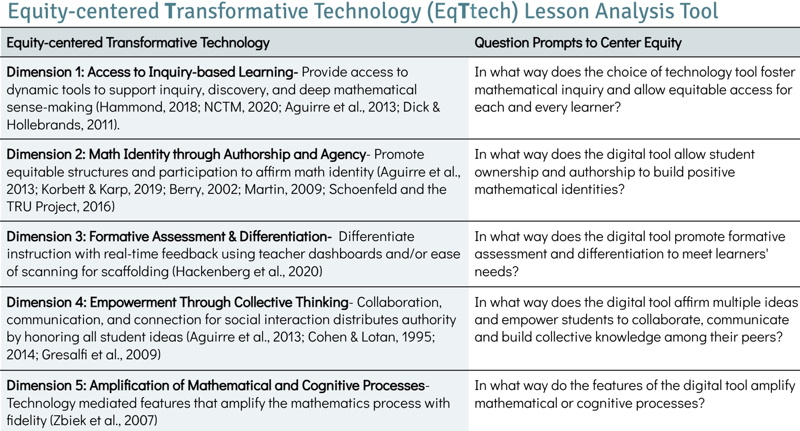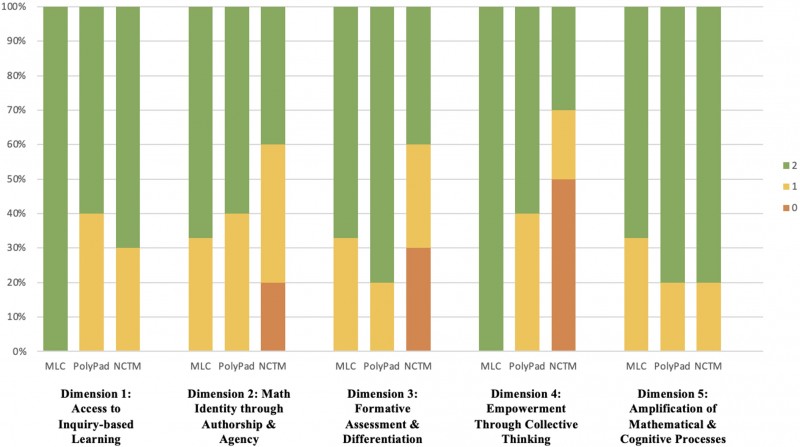Preservice Teachers’ Perceptions of How Virtual Manipulatives Promote Equity
Preservice Teachers’ Perceptions of How Virtual Manipulatives Promote Equity
Introduction
Our programs for preservice mathematics teachers (PSTs) strive to integrate the 2020 National Council of Teachers of Mathematics (NCTM) standards 4c “Incorporate Mathematics-Specific Tools” and 6a “Promote Equitable Learning Environments” as well as the 2017 Association of Mathematics Teacher Educator (AMTE) Standards for Preparing Teachers of Mathematics (SPTM) C.1.6. “Use Mathematical Tools and Technology” and C.2.1. “Promote Equitable Teaching” to prepare PSTs to use math technology as a vehicle for promoting equitable teaching. In this blog post, we: (1) describe an equity-centered tool that PSTs can use to analyze math technology, (2) describe the evolution of an instructional activity using the tool and the results, and (3) explain our next steps.
Equity-centered Transformative Technology Lesson Analysis Tool
The Equity-centered Transformative Technology (EqTtech) Lesson Analysis Tool (LAT) was developed to support PSTs in using technology to support equity-centered practices (Suh et al., 2022). The tool comprises 5 dimensions, each highlighting an important element of an equity-centered lesson (see Figure 1).
Figure 1
Equity-centered Transformative Technology (EqTtech) Lesson Analysis Tool (Suh et al., 2022)

Instructional Activities Using EqTtech
Initially, 18 elementary PSTs rated a virtual manipulative (VM) using the EqTtech LAT. PSTs were not asked to complete a particular task with the VMs; rather, they were prompted to spend at least 30 minutes exploring the features of a VM of their choice from either the Math Learning Center (MLC), NCTM Illuminations Interactives, or Mathigon Polypad. PSTs were asked to rate the VM of their choice as either (2) fully, (1) partially, or (0) not satisfying each of the five dimensions of the EqTtech LAT. As seen in Figure 2, most PSTs rated their VMs as fully (50-78%) or partially (22-39%), satisfying the dimensions of the EqTtech LAT.
Figure 2
PSTs Ratings of VM Across The EqTtech Dimensions

PSTs were also asked to justify their EqTtech ratings. We used open coding (Corbin & Strauss, 2014) to analyze PSTs’ justifications. The themes that emerged revealed that the PSTs’ had three misconceptions about VMs, including: (1) Concrete manipulatives are superior to VMs in all contexts, (2) VMs should be used after direct instruction, and (3) VMs are only beneficial for remedial learners or certain learning styles. Representative quotes can be found in Table 1. We suspect these misconceptions may be rooted in the PSTs' experiences as mathematics students. These misconceptions could be barriers to equity-centered instruction because each and every student should have access to inquiry-based learning (Dimension 1) and author their mathematical identity using tools of their choice (Dimension 2). Manipulatives, especially VMs, have the potential to amplify mathematics (Dimension 5), allow students the ability to collaborate (Dimension 4), and provide the opportunity for the teacher to gather quick formative assessment data (Dimension 3).
Table 1
Representative Quotes Unveiled Misconceptions
|
|
|
|
|
|
|
|
|
|
|
|
Next Steps
Implementing the EqTtech LAT in several pre-service and in-service teacher classes revealed a need to add additional information, such as reading assignments, rich descriptions of the dimensions, and exemplar lessons. MTEs will find a wealth of resources in the Equity-centered Transformative Technology Supplementary Materials (Suh et al., 2022). In the next iteration, PSTs will be exposed to the following pre-reading to support their understanding of technology use in mathematics: (1) “Strategic Use of Technology in Teaching and Learning Mathematics,” NCTM Position Statement, July 2015, (2) Tech-Knowledgy and diverse learners (Suh, 2010), (3) Enhancing and transforming virtual instruction (Barlow et al., 2020), and (4) Positioning Students to Explore Math with Technology (McCulloch et al., 2021). These readings will support PSTs in debunking common misconceptions and encourage the use of equity-centered technology
Implications
The EqTtech LAT can provide a framework for PSTs to evaluate technology tools used in mathematics classes. Evaluating technology use is essential in ensuring that the technology promotes effective mathematics practices and aligns with learning goals. PSTs need support in evaluating the variety of tools available to them. When PSTs analyze the technology tools they are using in lesson plans, they can ensure the tools amplify the mathematics, and support equity-centered practices (Aguirre et al., 2013). The Supplemental Materials on AMTE’s website provide four modules that MTEs might use to support this work. Although this work is focused on elementary tools, it can easily be extended to tools used at the secondary or postsecondary levels.
Learning goals need to be the primary focus of mathematics instruction, then technology tools that fit the learning goal can be selected. Features of technology tools that meet the dimensions outlined in the EqTtech LAT include access to inquiry-based learning, amplifying the mathematics, encouraging problem-solving, and providing data for teachers to learn about student thinking. However, the enactment of the lesson is just as necessary as the lesson itself. Educators need to allow students the freedom to explore and problem-solve using technology to promote equity-centered practices.
References
Aguire, J., Mayfield-Ingram, K., & Martin, D. (2013). Impact of identity on K-8 mathematics. National Council of Teachers of Mathematics. http://public.eblib.com/choice/PublicFullRecord.aspx?p=6564283
Association of Mathematics Teacher Educators (2017). Standards for Preparing Teachers of Mathematics. Available online at: https://amte.net/standards
Barlow, A., Edwards, C. M., Robichaux-Davis, R., & Sears, R. (2020). Enhancing and Transforming Virtual Instruction, Mathematics Teacher: Learning and Teaching PK-12, 113(12), 972-982. Retrieved Jul 27, 2021.
Corbin, J., & Strauss, A. (2014). Basics of qualitative research: Techniques and procedures for developing grounded theory (4th ed.). Thousand Oaks, CA: Sage.
McCulloch, A.W., Lovett, J.N., Dick, L.K. & Cayton, C. (2021). Positioning Students to Explore Math with Technology. Mathematics Teacher: Learning and Teaching PK–12, 114(10), 738–49.
National Council of Teachers of Mathematics (2020). NCTM 2020 Standards for Mathematics Teacher Preparation. Available online at: https://www.nctm.org/Standards_for_Teacher_Prep_Programs/
Suh, J. M. (2010). Tech-knowledgy and diverse learners. Mathematics teaching in the middle school, 15(8), 440-447.
Suh, J., Roscioli, K., Leong, K., & Tate, H. (2022). Transformative technology for
equity-centered instruction. Proceedings of Society for Information Technology & Teacher Education International Conference, 2022. 1392–1400. San Diego: Association for the Advancement of Computing in Education (AACE) http://www.learntechlib.org/primary/p/22092
Additional Resources
Math Tech-knowledgy for Equity: Equity-centered Transformative Technology (EQTTech)
http://mathtechknowledgy.onmason.com/
Suh, J., Roscioli, K., Tate, H., Morrow- Leong, K. (2022). Equity-Centered Transformative Technology. AMTE Supplemental Materials. https://amte.net/content/equity-centered-transformative-technology-eqttech
Suh, J., & Roscioli, K. (2022). Learning Trajectory-based Formative Assessment & Sequenced
Digital Learning Activities in Math Class. In C. L. Webb & A. L. Lindner (Eds.), Preparing Pre-Service Teachers to Integrate Technology in K-12 Classrooms: Standards and Best Practices (pp. 271–294). IGI Global.
